OCA/OCP Java SE 7 Programmer I & II Study Guide (Exams 1Z0-803 & 1Z0-804) (2015)
Part 2. OCP
Chapter 12. Inner Classes
CERTIFICATION OBJECTIVES
• Create Top-Level and Nested Classes
• Inner Classes
• Method-Local Inner Classes
• Anonymous Inner Classes
• Static Nested Classes
![]() Two-Minute Drill
Two-Minute Drill
Q&A Self Test
Inner classes (including static nested classes) appear throughout the exam. Although there are no official exam objectives exclusively about inner classes, OCP Objective 2.4 includes inner (aka nested) classes. More importantly, the code used to represent questions on virtually any topic on the exam can involve inner classes. Unless you deeply understand the rules and syntax for inner classes, you’re likely to miss questions you’d otherwise be able to answer. As if the exam weren’t already tough enough.
This chapter looks at the ins and outs (inners and outers?) of inner classes, and exposes you to the kinds of (often strange-looking) syntax examples you’ll see scattered throughout the entire exam. So you’ve really got two goals for this chapter—to learn what you’ll need to answer questions testing your inner class knowledge, and to learn how to read and understand inner class code so that you can handle questions testing your knowledge of other topics.
So what’s all the hoopla about inner classes? Before we get into it, we have to warn you (if you don’t already know) that inner classes have inspired passionate love ‘em or hate ‘em debates since first introduced in version 1.1 of the language. For once, we’re going to try to keep our opinions to ourselves here and just present the facts as you’ll need to know them for the exam. It’s up to you to decide how—and to what extent—you should use inner classes in your own development. We mean it. We believe they have some powerful, efficient uses in very specific situations, including code that’s easier to read and maintain, but they can also be abused and lead to code that’s as clear as a cornfield maze and to the syndrome known as “reuseless”: code that’s useless over and over again.
Inner classes let you define one class within another. They provide a type of scoping for your classes, since you can make one class a member of another class. Just as classes have member variables and methods, a class can also have member classes. They come in several flavors, depending on how and where you define the inner class, including a special kind of inner class known as a “top-level nested class” (an inner class marked static), which technically isn’t really an inner class. Because a static nested class is still a class defined within the scope of another class, we’re still going to cover them in this chapter on inner classes.
Most of the questions on the exam that make use of inner classes are focused on other certification topics and only use inner classes along the way. So for this chapter, the Certification Objective headings in the following list represent the four inner class topics discussed in this chapter, rather than four official exam objectives:
![]() Inner classes
Inner classes
![]() Method-local inner classes
Method-local inner classes
![]() Anonymous inner classes
Anonymous inner classes
![]() Static nested classes
Static nested classes
CERTIFICATION OBJECTIVES
Nested Classes (OCP Objective 2.4)
2.4 Create top-level and nested classes.
Note: As we’ve mentioned, mapping Objective 2.4 to this chapter is somewhat accurate, but it’s also a bit misleading. You’ll find inner classes used for many different exam topics. For that reason, we’re not going to keep saying that this chapter is for Objective 2.4.
Inner Classes
You’re an OO programmer, so you know that for reuse and flexibility/extensibility, you need to keep your classes specialized. In other words, a class should have code only for the things an object of that particular type needs to do; any other behavior should be part of another class better suited for that job. Sometimes, though, you find yourself designing a class where you discover you need behavior that belongs in a separate, specialized class, but also needs to be intimately tied to the class you’re designing.
Event handlers are perhaps the best example of this (and are, in fact, one of the main reasons inner classes were added to the language in the first place). If you have a GUI class that performs some job, like, say, a chat client, you might want the chat-client–specific methods (accept input, read new messages from server, send user input back to server, and so on) to be in the class. But how do those methods get invoked in the first place? A user clicks a button. Or types some text in the input field. Or a separate thread doing the I/O work of getting messages from the server has messages that need to be displayed in the GUI. So you have chat-client–specific methods, but you also need methods for handling the “events” (button presses, keyboard typing, I/O available, and so on) that drive the calls on those chat-client methods. The ideal scenario—from an OO perspective—is to keep the chat-client–specific methods in the ChatClient class and put the event-handling code in a separate event-handling class.
Nothing unusual about that so far; after all, that’s how you’re supposed to design OO classes. As specialists. But here’s the problem with the chat-client scenario: The event-handling code is intimately tied to the chat-client–specific code! Think about it: When the user clicks a Send button (indicating that they want their typed-in message to be sent to the chat server), the chat-client code that sends the message needs to read from a particular text field. In other words, if the user clicks Button A, the program is supposed to extract the text from the TextField Bof a particular ChatClient instance. Not from some other text field from some other object, but specifically the text field that a specific instance of the ChatClient class has a reference to. So the event-handling code needs access to the members of the ChatClient object to be useful as a “helper” to a particular ChatClient instance.
And what if the ChatClient class needs to inherit from one class, but the event-handling code is better off inheriting from some other class? You can’t make a class extend more than one class, so putting all the code (the chat-client-specific code and the event-handling code) in one class won’t work in that case. So what you’d really like to have is the benefit of putting your event code in a separate class (better OO, encapsulation, and the ability to extend a class other than the class the ChatClient extends), but still allow the event-handling code to have easy access to the members of the ChatClient (so the event-handling code can, for example, update the ChatClient’s private instance variables). You could manage it by making the members of the ChatClient accessible to the event-handling class by, for example, marking them public. But that’s not a good solution either.
You already know where this is going—one of the key benefits of an inner class is the “special relationship” an inner class instance shares with an instance of the outer class. That “special relationship” gives code in the inner class access to members of the enclosing (outer) class,as if the inner class were part of the outer class. In fact, that’s exactly what it means: The inner class is a part of the outer class. Not just a “part,” but a full-fledged, card-carrying member of the outer class. Yes, an inner class instance has access to all members of the outer class, even those marked private. (Relax, that’s the whole point, remember? We want this separate inner class instance to have an intimate relationship with the outer class instance, but we still want to keep everyone else out. And besides, if you wrote the outer class, then you also wrote the inner class! So you’re not violating encapsulation; you designed it this way.)
Coding a “Regular” Inner Class
We use the term regular here to represent inner classes that are not
![]() Static
Static
![]() Method-local
Method-local
![]() Anonymous
Anonymous
For the rest of this section, though, we’ll just use the term “inner class” and drop the “regular.” (When we switch to one of the other three types in the preceding list, you’ll know it.) You define an inner class within the curly braces of the outer class:

Piece of cake. And if you compile it:
![]()
you’ll end up with two class files:
![]()
The inner class is still, in the end, a separate class, so a separate class file is generated for it. But the inner class file isn’t accessible to you in the usual way. You can’t say
![]()
in hopes of running the main() method of the inner class, because a regular inner class cannot have static declarations of any kind. The only way you can access the inner class is through a live instance of the outer class! In other words, only at runtime, when there’s already an instance of the outer class to tie the inner class instance to. You’ll see all this in a moment. First, let’s beef up the classes a little:

The preceding code is perfectly legal. Notice that the inner class is indeed accessing a private member of the outer class. That’s fine, because the inner class is also a member of the outer class. So just as any member of the outer class (say, an instance method) can access any other member of the outer class, private or not, the inner class—also a member—can do the same.
Okay, so now that we know how to write the code giving an inner class access to members of the outer class, how do you actually use it?
Instantiating an Inner Class
To create an instance of an inner class, you must have an instance of the outer classto tie to the inner class. There are no exceptions to this rule: An inner class instance can never stand alone without a direct relationship to an instance of the outer class.
Instantiating an Inner Class from Within the Outer Class
Most often, it is the outer class that creates instances of the inner class, since it is usually the outer class wanting to use the inner instance as a helper for its own personal use. We’ll modify the MyOuter class to create an instance of MyInner:

You can see in the preceding code that the MyOuter code treats MyInner just as though MyInner were any other accessible class—it instantiates it using the class name (new MyInner()) and then invokes a method on the reference variable (in.seeOuter()). But the only reason this syntax works is because the outer class instance method code is doing the instantiating. In other words, there’s already an instance of the outer class—the instance running themakeInner() method.So how do you instantiate a MyInner object from somewhere outside the MyOuter class? Is it even possible? (Well, since we’re going to all the trouble of making a whole new subhead for it, as you’ll see next, there’s no big mystery here.)
Creating an Inner Class Object from Outside the Outer Class Instance Code Whew. Long subhead there, but it does explain what we’re trying to do. If we want to create an instance of the inner class, we must have an instance of the outer class. You already know that, but think about the implications… it means that without a reference to an instance of the outer class, you can’t instantiate the inner class from a static method of the outer class (because, don’t forget, in static code, there is nothis reference), or from any other code in any other class. Inner class instances are always handed an implicit reference to the outer class. The compiler takes care of it, so you’ll never see anything but the end result—the ability of the inner class to access members of the outer class. The code to make an instance from anywhere outside nonstatic code of the outer class is simple, but you must memorize this for the exam!

The preceding code is the same, regardless of whether the main() method is within the MyOuter class or some other class (assuming the other class has access to MyOuter, and since MyOuter has default access, that means the code must be in a class within the same package as MyOuter).
If you’re into one-liners, you can do it like this:

You can think of this as though you’re invoking a method on the outer instance, but the method happens to be a special inner class instantiation method, and it’s invoked using the keyword new. Instantiating an inner class is the only scenario in which you’ll invoke new on an instance as opposed to invoking new to construct an instance.
Here’s a quick summary of the differences between inner class instantiation code that’s within the outer class (but not static), and inner class instantiation code that’s outside the outer class:
![]() From inside the outer class instance code, use the inner class name in the normal way:
From inside the outer class instance code, use the inner class name in the normal way:
![]()
![]() From outside the outer class instance code (including static method code within the outer class), the inner class name must now include the outer class’s name:
From outside the outer class instance code (including static method code within the outer class), the inner class name must now include the outer class’s name:
MyOuter.MyInner
To instantiate it, you must use a reference to the outer class:
new MyOuter().new MyInner(); or outerObjRef.new MyInner();
if you already have an instance of the outer class.
Referencing the Inner or Outer Instance from Within the Inner Class
How does an object refer to itself normally? By using the this reference. Here is a quick review of this:
![]() The keyword this can be used only from within instance code. In other words, not within static code.
The keyword this can be used only from within instance code. In other words, not within static code.
![]() The this reference is a reference to the currently executing object. In other words, the object whose reference was used to invoke the currently running method.
The this reference is a reference to the currently executing object. In other words, the object whose reference was used to invoke the currently running method.
![]() The this reference is the way an object can pass a reference to itself to some other code as a method argument:
The this reference is the way an object can pass a reference to itself to some other code as a method argument:

Within an inner class code, the this reference refers to the instance of the inner class, as you’d probably expect, since this always refers to the currently executing object. But what if the inner class code wants an explicit reference to the outer class instance that the inner instance is tied to? In other words, how do you reference the “outer this”? Although normally, the inner class code doesn’t need a reference to the outer class, since it already has an implicit one it’s using to access the members of the outer class, it would need a reference to the outer class if it needed to pass that reference to some other code, as follows:

If we run the complete code as follows:
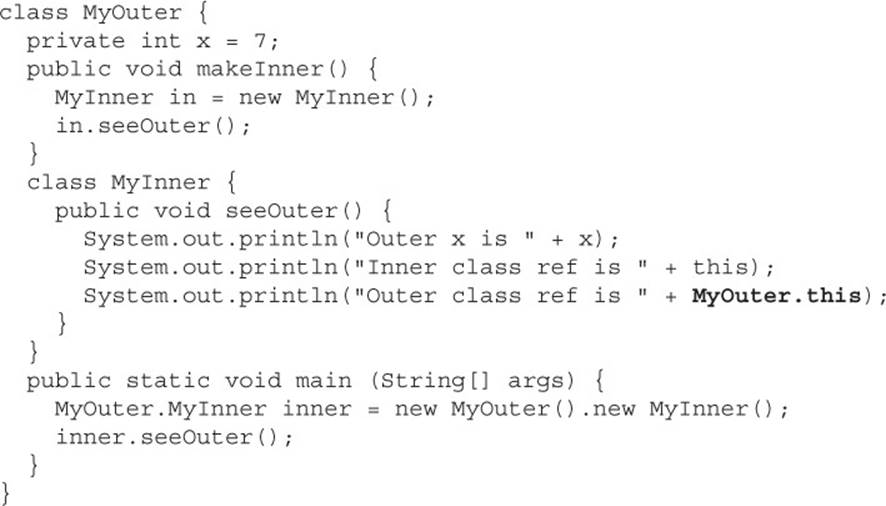
the output is something like this:

So the rules for an inner class referencing itself or the outer instance are as follows:
![]() To reference the inner class instance itself from withinthe inner class code, use this.
To reference the inner class instance itself from withinthe inner class code, use this.
![]() To reference the “outer this” (the outer class instance) from within the inner class code, use NameOfOuterClass.this (example, MyOuter.this).
To reference the “outer this” (the outer class instance) from within the inner class code, use NameOfOuterClass.this (example, MyOuter.this).
Member Modifiers Applied to Inner Classes
A regular inner class is a member of the outer class just as instance variables and methods are, so the following modifiers can be applied to an inner class:
![]() final
final
![]() abstract
abstract
![]() public
public
![]() private
private
![]() protected
protected
![]() static—but static turns it into a static nested class, not an inner class
static—but static turns it into a static nested class, not an inner class
![]() strictfp
strictfp
CERTIFICATION OBJECTIVES
Method-Local Inner Classes
A regular inner class is scoped inside another class’s curly braces, but outside any method code (in other words, at the same level that an instance variable is declared). But you can also define an inner class within a method:

The preceding code declares a class, MyOuter2, with one method, doStuff(). But inside doStuff(), another class, MyInner, is declared, and it has a method of its own, seeOuter(). The previous code is completely useless, however, because it never instantiates the inner class! Just because you declared the class doesn’t mean you created an instance of it. So to use the inner class, you must make an instance of it somewhere within the method but below the inner class definition(or the compiler won’t be able to find the inner class). The following legal code shows how to instantiate and use a method-local inner class:
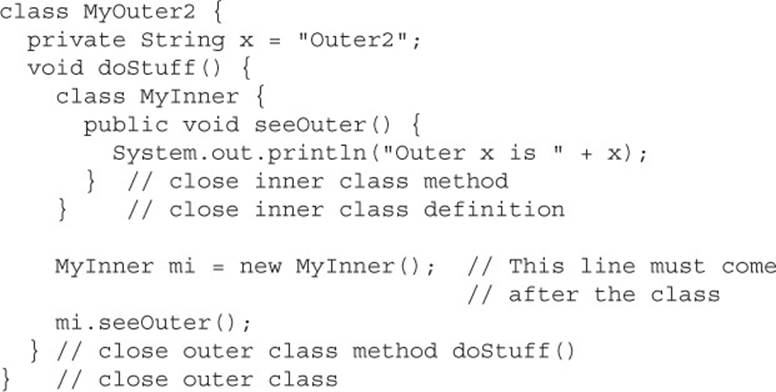
What a Method-Local Inner Object Can and Can’t Do
A method-local inner class can be instantiated only within the method where the inner class is defined. In other words, no other code running in any other method—inside or outside the outer class—can ever instantiate the method-local inner class. Like regular inner class objects, the method-local inner class object shares a special relationship with the enclosing (outer) class object and can access its private (or any other) members. However, the inner class object cannot use the local variables of the method the inner class is in. Why not?
Think about it. The local variables of the method live on the stack and exist only for the lifetime of the method. You already know that the scope of a local variable is limited to the method the variable is declared in. When the method ends, the stack frame is blown away and the variable is history. But even after the method completes, the inner class object created within it might still be alive on the heap if, for example, a reference to it was passed into some other code and then stored in an instance variable. Because the local variables aren’t guaranteed to be alive as long as the method-local inner class object is, the inner class object can’t use them. Unless the local variables are marked final! The following code attempts to access a local variable from within a method-local inner class:
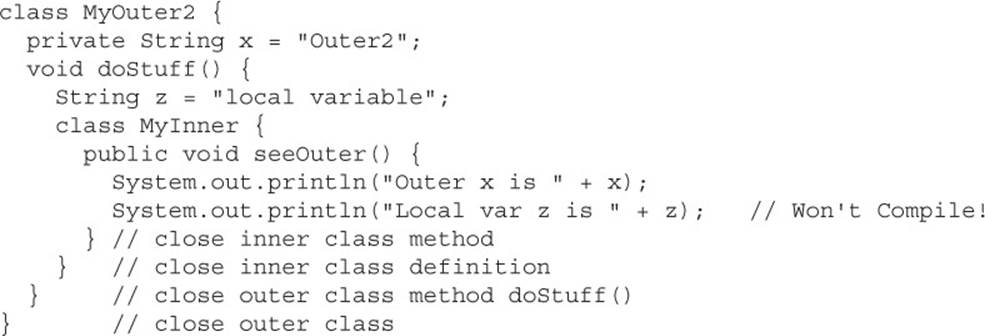
Compiling the preceding code really upsets the compiler:
MyOuter2.java:8: local variable z is accessed from within inner class;
Marking the local variable z as final fixes the problem:
final String z = "local var"; // Now inner object can use it
And just a reminder about modifiers within a method: The same rules apply to method-local inner classes as to local variable declarations. You can’t, for example, mark a method-local inner class public, private, protected, static, transient, and the like. For the purpose of the exam, the only modifiers you can apply to a method-local inner class are abstract and final, but, as always, never both at the same time.

Remember that a local class declared in a static method has access to only static members of the enclosing class, since there is no associated instance of the enclosing class. If you’re in a static method, there is no this, so an inner class in a staticmethod is subject to the same restrictions as the static method. In other words, no access to instance variables.
CERTIFICATION OBJECTIVES
Anonymous Inner Classes
So far, we’ve looked at defining a class within an enclosing class (a regular inner class) and within a method (a method-local inner class). Finally, we’re going to look at the most unusual syntax you might ever see in Java: inner classes declared without any class name at all (hence, the word anonymous). And if that’s not weird enough, you can define these classes not just within a method, but even within an argument to a method. We’ll look first at the plain-old (as if there is such a thing as a plain-old anonymous inner class) version (actually, even the plain-old version comes in two flavors), and then at the argument-declared anonymous inner class.
Perhaps your most important job here is to learn to not be thrown when you see the syntax. The exam is littered with anonymous inner class code—you might see it on questions about threads, wrappers, overriding, garbage collection, and… well, you get the idea.
Plain-Old Anonymous Inner Classes, Flavor One
Check out the following legal-but-strange-the-first-time-you-see-it code:
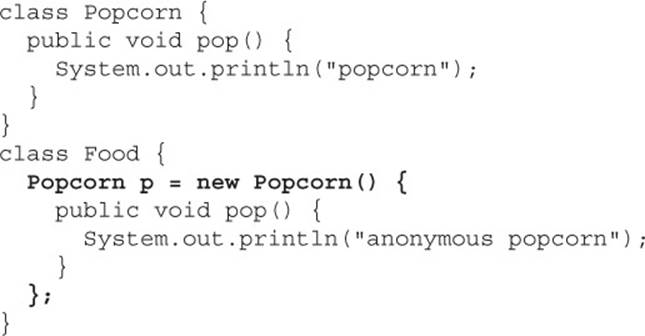
Let’s look at what’s in the preceding code:
![]() We define two classes: Popcorn and Food.
We define two classes: Popcorn and Food.
![]() Popcorn has one method: pop().
Popcorn has one method: pop().
![]() Food has one instance variable, declared as type Popcorn. That’s it for Food. Food has no methods.
Food has one instance variable, declared as type Popcorn. That’s it for Food. Food has no methods.
And here’s the big thing to get:
The Popcorn reference variable refers not to an instance of Popcorn, but to an instance of an anonymous (unnamed) subclass of Popcorn.
Let’s look at just the anonymous class code:

Line 2 Line 2 starts out as an instance variable declaration of type Popcorn. But instead of looking like this:
![]()
there’s a curly brace at the end of line 2, where a semicolon would normally be.
![]()
You can read line 2 as saying,
Declare a reference variable, p, of type Popcorn. Then declare a new class that has no name but that is a subclass of Popcorn. And here’s the curly brace that opens the class definition…
Line 3 Line 3, then, is actually the first statement within the new class definition. And what is it doing? Overriding the pop() method of the superclass Popcorn. This is the whole point of making an anonymous inner class—to override one or more methods of the superclass!(Or to implement methods of an interface, but we’ll save that for a little later.)
Line 4 Line 4 is the first (and in this case only) statement within the overriding pop() method. Nothing special there.
Line 5 Line 5 is the closing curly brace of the pop() method. Nothing special.
Line 6 Here’s where you have to pay attention: Line 6 includes a curly brace closing off the anonymous class definition(it’s the companion brace to the one on line 2), but there’s more! Line 6 also has the semicolon that ends the statement started on line 2—the statement where it all began—the statement declaring and initializing the Popcorn reference variable. And what you’re left with is a Popcorn reference to a brand-new instance of a brand-new, just-in-time, anonymous (no name) subclass of Popcorn.

The closing semicolon is hard to spot. Watch for code like this:

You’ll need to be especially careful about the syntax when inner classes are involved, because the code on line 6 looks perfectly natural. It’s rare to see semicolons following curly braces.
Polymorphism is in play when anonymous inner classes are involved. Remember that, as in the preceding Popcorn example, we’re using a superclass reference variable type to refer to a subclass object. What are the implications? You can only call methods on an anonymous inner class reference that are defined in the reference variable type! This is no different from any other polymorphic references—for example,
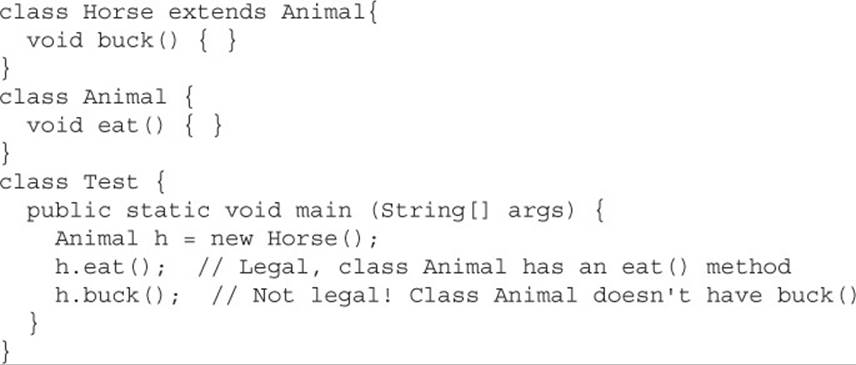
So on the exam, you must be able to spot an anonymous inner class that—rather than overriding a method of the superclass—defines its own new method. The method definition isn’t the problem, though; the real issue is, how do you invoke that new method? The reference variable type (the superclass) won’t know anything about that new method (defined in the anonymous subclass), so the compiler will complain if you try to invoke any method on an anonymous inner class reference that is not in the superclass class definition.
Check out the following illegal code:
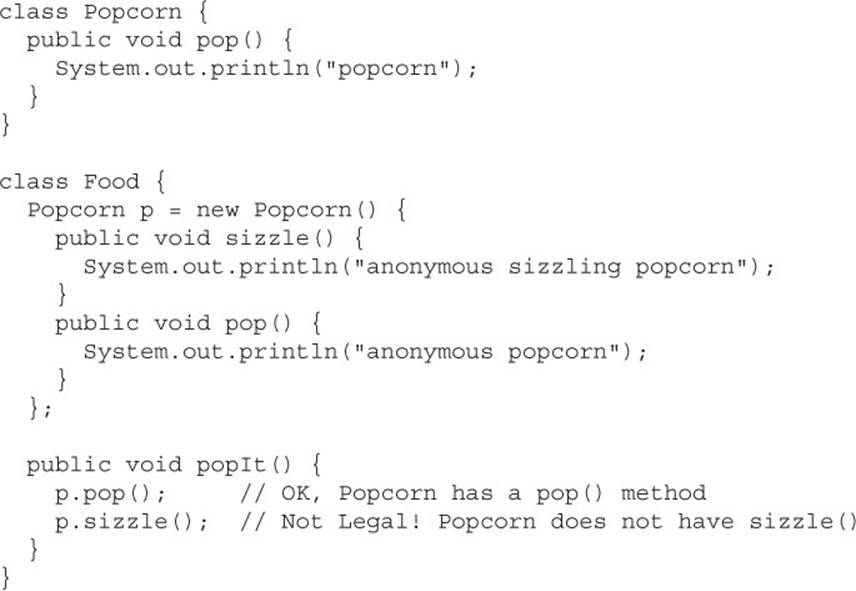
Compiling the preceding code gives us something like this:

which is the compiler’s way of saying, “I can’t find method sizzle() in class Popcorn,” followed by, “Get a clue.”
Plain-Old Anonymous Inner Classes, Flavor Two
The only difference between flavor one and flavor two is that flavor one creates an anonymous subclass of the specified class type, whereas flavor two creates an anonymous implementer of the specified interface type. In the previous examples, we defined a new anonymous subclass of type Popcorn as follows:
![]()
But if Popcorn were an interface type instead of a class type, then the new anonymous class would be an implementer of the interface rather than a subclass of the class. Look at the following example:
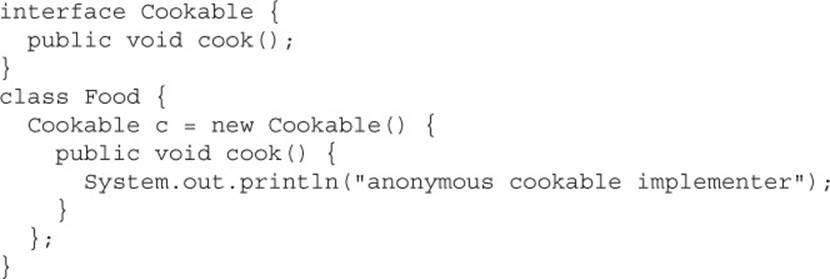
The preceding code, like the Popcorn example, still creates an instance of an anonymous inner class, but this time, the new just-in-time class is an implementer of the Cookable interface. And note that this is the only time you will ever see the syntax:
new Cookable()
where Cookable is an interface rather than a non abstract class type. Think about it: You can’t instantiate an interface, yet that’s what the code looks like it’s doing. But, of course, it’s not instantiating a Cookable object—it’s creating an instance of a new anonymous implementer ofCookable. You can read this line:
Cookable c = new Cookable() {
as, “Declare a reference variable of type Cookable that, obviously, will refer to an object from a class that implements the Cookable interface. But, oh yes, we don’t yet have a class that implements Cookable, so we’re going to make one right here, right now. We don’t need a name for the class, but it will be a class that implements Cookable, and this curly brace starts the definition of the new implementing class.” One more thing to keep in mind about anonymous interface implementers—they can implement only one interface. There simply isn’t any mechanism to say that your anonymous inner class is going to implement multiple interfaces. In fact, an anonymous inner class can’t even extend a class and implement an interface at the same time. The inner class has to choose either to be a subclass of a named class—and not directly implement any interfaces at all—or to implement a single interface. By directly, we mean actually using the keyword implements as part of the class declaration. If the anonymous inner class is a subclass of a class type, it automatically becomes an implementer of any interfaces implemented by the superclass.

Don’t be fooled by any attempts to instantiate an interface except in the case of an anonymous inner class. The following is not legal:
![]()
whereas the following is legal, because it’s instantiating an implementer of the Runnable interface (an anonymous implementation class):

Argument-Defined Anonymous Inner Classes
If you understood what we’ve covered so far in this chapter, then this last part will be simple. If you are still a little fuzzy on anonymous classes, however, then you should re-read the previous sections. If they’re not completely clear, we’d like to take full responsibility for the confusion. But we’ll be happy to share.
Okay, if you’ve made it to this sentence, then we’re all going to assume you understood the preceding section, and now we’re just going to add one new twist. Imagine the following scenario. You’re typing along, creating the Perfect Class, when you write code calling a method on a Bar object, and that method takes an object of type Foo (an interface).

No problemo, except that you don’t have an object from a class that implements Foo, and you can’t instantiate one, either, because you don’t even have a class that implements Foo, let alone an instance of one. So you first need a class that implements Foo, and then you need an instance of that class to pass to the Bar class’s doStuff() method. Savvy Java programmer that you are, you simply define an anonymous inner class, right inside the argument. That’s right, just where you least expect to find a class. And here’s what it looks like:

All the action starts on line 4. We’re calling doStuff() on a Bar object, but the method takes an instance that IS-A Foo, where Foo is an interface. So we must make both an implementation class and an instance of that class, all right here in the argument to doStuff(). So that’s what we do. We write
new Foo() {
to start the new class definition for the anonymous class that implements the Foo interface. Foo has a single method to implement, foof(), so on lines 5, 6, and 7, we implement the foof() method. Then on line 8—whoa!—more strange syntax appears. The first curly brace closes off the new anonymous class definition. But don’t forget that this all happened as part of a method argument, so the closing parenthesis,), finishes off the method invocation, and then we must still end the statement that began on line 4, so we end with a semicolon. Study this syntax! You will see anonymous inner classes on the exam, and you’ll have to be very, very picky about the way they’re closed. If they’re argument local, they end like this:
});
but if they’re just plain-old anonymous classes, then they end like this:
};
Regardless, the syntax is rare, so be careful. Any question from any part of the exam might involve anonymous inner classes as part of the code.
CERTIFICATION OBJECTIVES
Static Nested Classes
We saved the easiest for last, as a kind of treat. :)
You’ll sometimes hear static nested classes referred to as static inner classes, but they really aren’t inner classes at all based on the standard definition of an inner class. While an inner class (regardless of the flavor) enjoys that special relationship with the outer class (or rather, theinstances of the two classes share a relationship), a static nested class does not. It is simply a non-inner (also called “top-level”) class scoped within another. So with static classes, it’s really more about name-space resolution than about an implicit relationship between the two classes.
A static nested class is simply a class that’s a static member of the enclosing class:

The class itself isn’t really “static”; there’s no such thing as a static class. The static modifier in this case says that the nested class is a static member of the outer class. That means it can be accessed, as with other static members, without having an instance of the outer class.
Instantiating and Using Static Nested Classes
You use standard syntax to access a static nested class from its enclosing class. The syntax for instantiating a static nested class from a nonenclosing class is a little different from a normal inner class, and looks like this:

which produces
![]()

Just as a static method does not have access to the instance variables and nonstatic methods of the class, a static nested class does not have access to the instance variables and nonstatic methods of the outer class. Look for static nested classes with code that behaves like a nonstatic (regular inner) class.
CERTIFICATION SUMMARY
Inner classes will show up throughout the exam, in any topic, and these are some of the exam’s hardest questions. You should be comfortable with the sometimes bizarre syntax and know how to spot legal and illegal inner class definitions.
We looked first at “regular” inner classes, where one class is a member of another. You learned that coding an inner class means putting the class definition of the inner class inside the curly braces of the enclosing (outer) class, but outside of any method or other code block. You learned that an inner class instance shares a special relationship with a specific instance of the outer class, and that this special relationship lets the inner class access all members of the outer class, including those marked private. You learned that to instantiate an inner class, you musthave a reference to an instance of the outer class.
Next, we looked at method-local inner classes—classes defined inside a method. The code for a method-local inner class looks virtually the same as the code for any other class definition, except that you can’t apply an access modifier the way you can with a regular inner class. You learned why method-local inner classes cannot use non-final local variables declared within the method—the inner class instance may outlive the stack frame, so the local variable might vanish while the inner class object is still alive. You saw that to use the inner class you need to instantiate it and that the instantiation must come after the class declaration in the method.
We also explored the strangest inner class type of all—the anonymous inner class. You learned that they come in two forms: normal and argument-defined. Normal, ho-hum, anonymous inner classes are created as part of a variable assignment, while argument-defined inner classes are actually declared, defined, and automatically instantiated all within the argument to a method! We covered the way anonymous inner classes can be either a subclass of the named class type or an implementer of the named interface. Finally, we looked at how polymorphism applies to anonymous inner classes: You can invoke on the new instance only those methods defined in the named class or interface type. In other words, even if the anonymous inner class defines its own new method, no code from anywhere outside the inner class will be able to invoke that method.
As if we weren’t already having enough fun for one day, we pushed on to static nested classes, which really aren’t inner classes at all. Known as static nested classes, a nested class marked with the static modifier is quite similar to any other non-inner class, except that to access it, code must have access to both the nested and enclosing class. We saw that because the class is static, no instance of the enclosing class is needed, and thus the static nested class does not share a special relationship with any instance of the enclosing class. Remember, static inner classes can’t access instance methods or variables.
![]() TWO-MINUTE DRILL
TWO-MINUTE DRILL
Here are some of the key points from this chapter.
Inner Classes
![]() A “regular” inner class is declared inside the curly braces of another class, but outside any method or other code block.
A “regular” inner class is declared inside the curly braces of another class, but outside any method or other code block.
![]() An inner class is a full-fledged member of the enclosing (outer) class, so it can be marked with an access modifier as well as the abstract or final modifiers. (Never both abstract and final together—remember that abstract must be subclassed, whereas final cannot be subclassed.)
An inner class is a full-fledged member of the enclosing (outer) class, so it can be marked with an access modifier as well as the abstract or final modifiers. (Never both abstract and final together—remember that abstract must be subclassed, whereas final cannot be subclassed.)
![]() An inner class instance shares a special relationship with an instance of the enclosing class. This relationship gives the inner class access to all of the outer class’s members, including those marked private.
An inner class instance shares a special relationship with an instance of the enclosing class. This relationship gives the inner class access to all of the outer class’s members, including those marked private.
![]() To instantiate an inner class, you must have a reference to an instance of the outer class.
To instantiate an inner class, you must have a reference to an instance of the outer class.
![]() From code within the enclosing class, you can instantiate the inner class using only the name of the inner class, as follows:
From code within the enclosing class, you can instantiate the inner class using only the name of the inner class, as follows:
MyInner mi = new MyInner();
![]() From code outside the enclosing class’s instance methods, you can instantiate the inner class only by using both the inner and outer class names and a reference to the outer class, as follows:
From code outside the enclosing class’s instance methods, you can instantiate the inner class only by using both the inner and outer class names and a reference to the outer class, as follows:

![]() From code within the inner class, the keyword this holds a reference to the inner class instance. To reference the outer this (in other words, the instance of the outer class that this inner instance is tied to), precede the keyword this with the outer class name, as follows:MyOuter.this;
From code within the inner class, the keyword this holds a reference to the inner class instance. To reference the outer this (in other words, the instance of the outer class that this inner instance is tied to), precede the keyword this with the outer class name, as follows:MyOuter.this;
Method-Local Inner Classes
![]() A method-local inner class is defined within a method of the enclosing class.
A method-local inner class is defined within a method of the enclosing class.
![]() For the inner class to be used, you must instantiate it, and that instantiation must happen within the same method, but after the class definition code.
For the inner class to be used, you must instantiate it, and that instantiation must happen within the same method, but after the class definition code.
![]() A method-local inner class cannot use variables declared within the method (including parameters) unless those variables are marked final.
A method-local inner class cannot use variables declared within the method (including parameters) unless those variables are marked final.
![]() The only modifiers you can apply to a method-local inner class are abstract and final. (Never both at the same time, though.)
The only modifiers you can apply to a method-local inner class are abstract and final. (Never both at the same time, though.)
Anonymous Inner Classes
![]() Anonymous inner classes have no name, and their type must be either a subclass of the named type or an implementer of the named interface.
Anonymous inner classes have no name, and their type must be either a subclass of the named type or an implementer of the named interface.
![]() An anonymous inner class is always created as part of a statement; don’t forget to close the statement after the class definition with a curly brace. This is a rare case in Java, a curly brace followed by a semicolon.
An anonymous inner class is always created as part of a statement; don’t forget to close the statement after the class definition with a curly brace. This is a rare case in Java, a curly brace followed by a semicolon.
![]() Because of polymorphism, the only methods you can call on an anonymous inner class reference are those defined in the reference variable class (or interface), even though the anonymous class is really a subclass or implementer of the reference variable type.
Because of polymorphism, the only methods you can call on an anonymous inner class reference are those defined in the reference variable class (or interface), even though the anonymous class is really a subclass or implementer of the reference variable type.
![]() An anonymous inner class can extend one subclass or implement one interface. Unlike nonanonymous classes (inner or otherwise), an anonymous inner class cannot do both. In other words, it cannot both extend a class and implement an interface, nor can it implement more than one interface.
An anonymous inner class can extend one subclass or implement one interface. Unlike nonanonymous classes (inner or otherwise), an anonymous inner class cannot do both. In other words, it cannot both extend a class and implement an interface, nor can it implement more than one interface.
![]() An argument-defined inner class is declared, defined, and automatically instantiated as part of a method invocation. The key to remember is that the class is being defined within a method argument, so the syntax will end the class definition with a curly brace, followed by a closing parenthesis to end the method call, followed by a semicolon to end the statement: });
An argument-defined inner class is declared, defined, and automatically instantiated as part of a method invocation. The key to remember is that the class is being defined within a method argument, so the syntax will end the class definition with a curly brace, followed by a closing parenthesis to end the method call, followed by a semicolon to end the statement: });
Static Nested Classes
![]() Static nested classes are inner classes marked with the static modifier.
Static nested classes are inner classes marked with the static modifier.
![]() A static nested class is not an inner class; it’s a top-level nested class.
A static nested class is not an inner class; it’s a top-level nested class.
![]() Because the nested class is static, it does not share any special relationship with an instance of the outer class. In fact, you don’t need an instance of the outer class to instantiate a static nested class.
Because the nested class is static, it does not share any special relationship with an instance of the outer class. In fact, you don’t need an instance of the outer class to instantiate a static nested class.
![]() For the purposes of the exam, instantiating a static nested class requires using both the outer and nested class names as follows:
For the purposes of the exam, instantiating a static nested class requires using both the outer and nested class names as follows:
BigOuter.Nested n = new BigOuter.Nested();
![]() A static nested class cannot access nonstatic members of the outer class, since it does not have an implicit reference to any outer instance (in other words, the nested class instance does not get an outer this reference).
A static nested class cannot access nonstatic members of the outer class, since it does not have an implicit reference to any outer instance (in other words, the nested class instance does not get an outer this reference).
SELF TEST
The following questions will help you measure your understanding of the dynamic and life-altering material presented in this chapter. Read all of the choices carefully. Take your time. Breathe.
1. Which are true about a static nested class? (Choose all that apply.)
A. You must have a reference to an instance of the enclosing class in order to instantiate it
B. It does not have access to nonstatic members of the enclosing class
C. Its variables and methods must be static
D. If the outer class is named MyOuter and the nested class is named MyInner, it can be instantiated using new MyOuter.MyInner();
E. It must extend the enclosing class
2. Given:

Which statements create an anonymous inner class from within class Bar? (Choose all that apply.)
A. Boo f = new Boo(24) { };
B. Boo f = new Bar() { };
C. Boo f = new Boo() {String s; };
D. Bar f = new Boo(String s) { };
E. Boo f = new Boo.Bar(String s) { };
3. Which are true about a method-local inner class? (Choose all that apply.)
A. It must be marked final
B. It can be marked abstract
C. It can be marked public
D. It can be marked static
E. It can access private members of the enclosing class
4. Given:
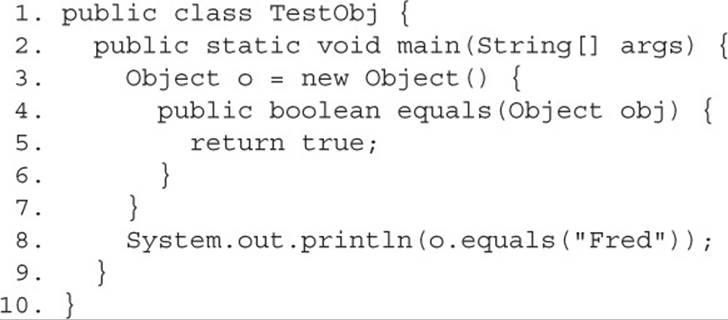
What is the result?
A. An exception occurs at runtime
B. true
C. Fred
D. Compilation fails because of an error on line 3
E. Compilation fails because of an error on line 4
F. Compilation fails because of an error on line 8
G. Compilation fails because of an error on a line other than 3, 4, or 8
5. Given:

What is the result?
A. An exception occurs at runtime at line 10
B. Zippo
C. Compilation fails because of an error on line 3
D. Compilation fails because of an error on line 9
E. Compilation fails because of an error on line 10
6. Given:
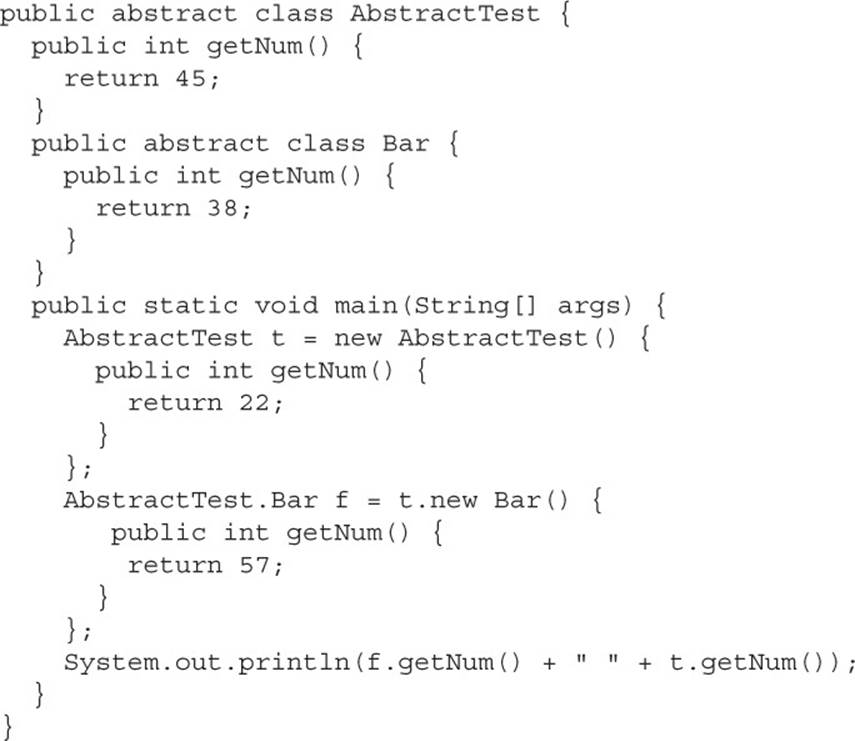
What is the result?
A. 57 22
B. 45 38
C. 45 57
D. An exception occurs at runtime
E. Compilation fails
7. Given:
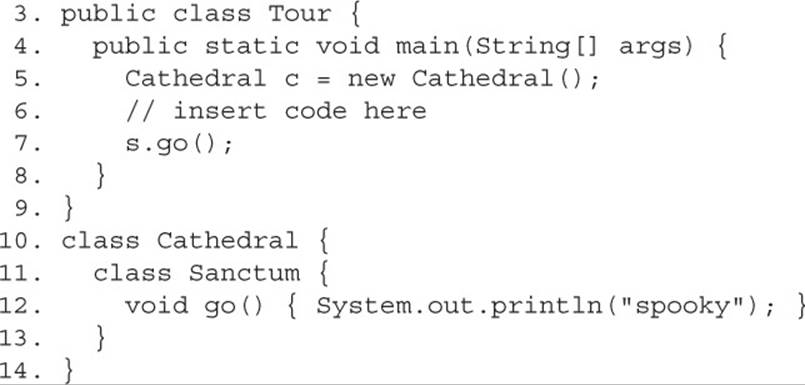
Which, inserted independently at line 6, compile and produce the output “spooky”? (Choose all that apply.)
A. Sanctum s = c.new Sanctum();
B. c.Sanctum s = c.new Sanctum();
C. c.Sanctum s = Cathedral.new Sanctum();
D. Cathedral.Sanctum s = c.new Sanctum();
E. Cathedral.Sanctum s = Cathedral.new Sanctum();
8. Given:
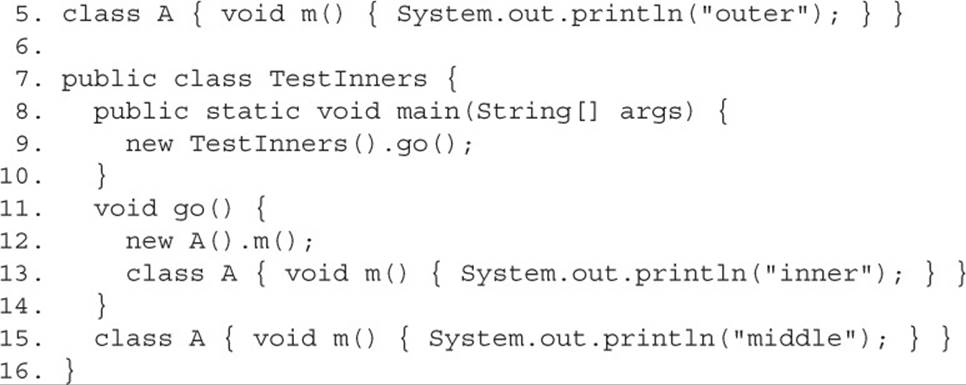
What is the result?
A. inner
B. outer
C. middle
D. Compilation fails
E. An exception is thrown at runtime
9. Given:
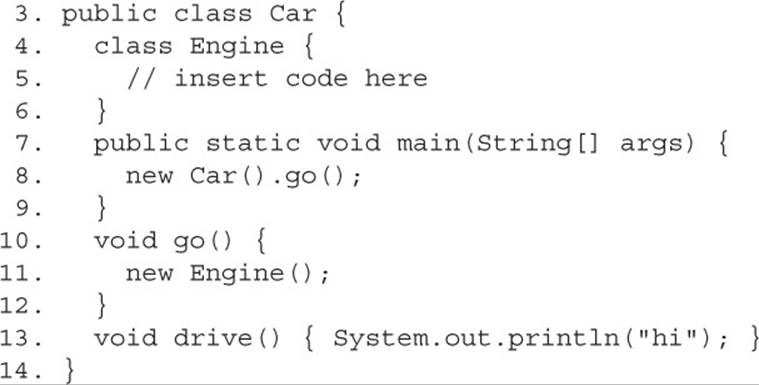
Which, inserted independently at line 5, produce the output “hi”? (Choose all that apply.)
A. { Car .drive(); }
B. { this.drive(); }
C. { Car.this.drive(); }
D. { this.Car.this.drive(); }
E. Engine() { Car.drive(); }
F. Engine() { this.drive(); }
G. Engine() { Car.th is.drive(); }
10. Given:
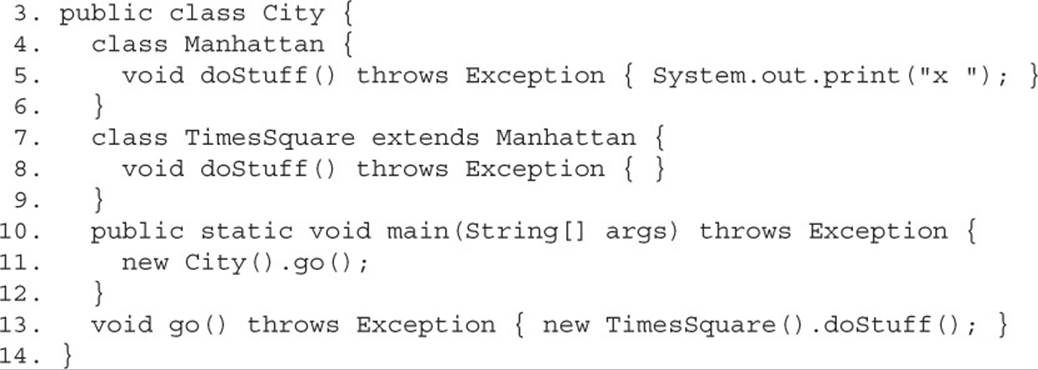
What is the result?
A. x
B. x x
C. No output is produced
D. Compilation fails due to multiple errors
E. Compilation fails due only to an error on line 4
F. Compilation fails due only to an error on line 7
G. Compilation fails due only to an error on line 10
H. Compilation fails due only to an error on line 13
11. Given:
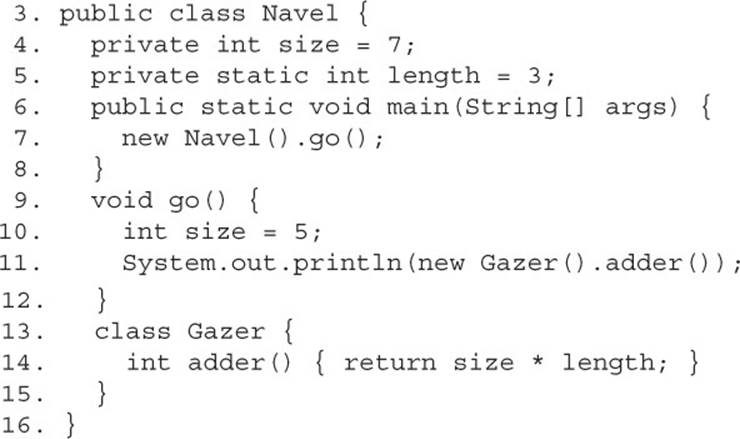
What is the result?
A. 15
B. 21
C. An exception is thrown at runtime
D. Compilation fails due to multiple errors
E. Compilation fails due only to an error on line 4
F. Compilation fails due only to an error on line 5
12. Given:
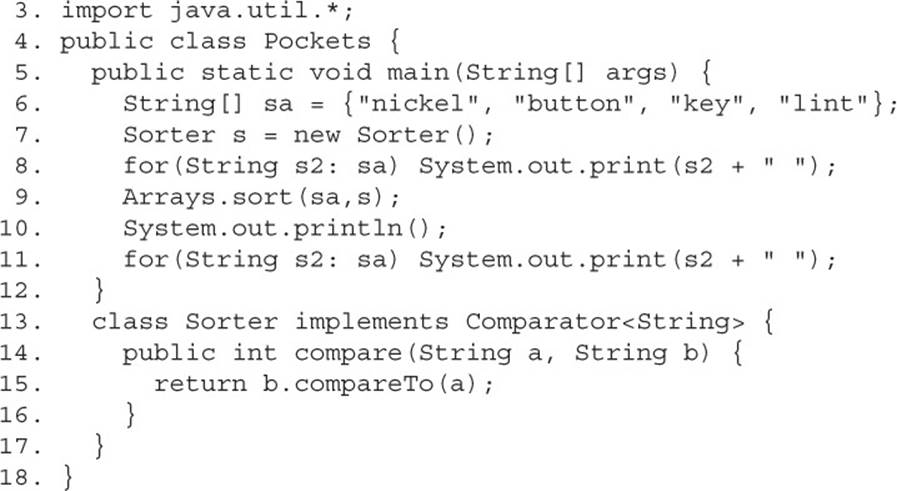
What is the result?

SELF TEST ANSWERS
Note: You could argue that all of the questions in this chapter relate to OCP Objective 2.4. We’ve talked about the actual mapping of inner class ideas to the exam, so we will NOT be citing Objective numbers in the answers to the questions in this chapter.
1. ![]() B and D are correct. B is correct because a static nested class is not tied to an instance of the enclosing class, and thus can’t access the nonstatic members of the class (just as a static method can’t access nonstatic members of a class). D uses the correct syntax for instantiating a static nested class.
B and D are correct. B is correct because a static nested class is not tied to an instance of the enclosing class, and thus can’t access the nonstatic members of the class (just as a static method can’t access nonstatic members of a class). D uses the correct syntax for instantiating a static nested class.
![]() A is incorrect because static nested classes do not need (and can’t use) a reference to an instance of the enclosing class. C is incorrect because static nested classes can declare and define nonstatic members. E is wrong because… it just is. There’s no rule that says an inner or nested class has to extend anything.
A is incorrect because static nested classes do not need (and can’t use) a reference to an instance of the enclosing class. C is incorrect because static nested classes can declare and define nonstatic members. E is wrong because… it just is. There’s no rule that says an inner or nested class has to extend anything.
2. ![]() B and C are correct. B is correct because anonymous inner classes are no different from any other class when it comes to polymorphism. That means you are always allowed to declare a reference variable of the superclass type and have that reference variable refer to an instance of a subclass type, which in this case is an anonymous subclass of Bar. Since Bar is a subclass of Boo, it all works. C uses correct syntax for creating an instance of Boo.
B and C are correct. B is correct because anonymous inner classes are no different from any other class when it comes to polymorphism. That means you are always allowed to declare a reference variable of the superclass type and have that reference variable refer to an instance of a subclass type, which in this case is an anonymous subclass of Bar. Since Bar is a subclass of Boo, it all works. C uses correct syntax for creating an instance of Boo.
![]() A is incorrect because it passes an int to the Boo constructor, and there is no matching constructor in the Boo class. D is incorrect because it violates the rules of polymorphism; you cannot refer to a superclass type using a reference variable declared as the subclass type. The superclass doesn’t have everything the subclass has. E uses incorrect syntax.
A is incorrect because it passes an int to the Boo constructor, and there is no matching constructor in the Boo class. D is incorrect because it violates the rules of polymorphism; you cannot refer to a superclass type using a reference variable declared as the subclass type. The superclass doesn’t have everything the subclass has. E uses incorrect syntax.
3. ![]() B and E are correct. B is correct because a method-local inner class can be abstract, although it means a subclass of the inner class must be created if the abstract class is to be used (so an abstract method-local inner class is probably not useful). E is correct because a method-local inner class works like any other inner class—it has a special relationship to an instance of the enclosing class, thus it can access all members of the enclosing class.
B and E are correct. B is correct because a method-local inner class can be abstract, although it means a subclass of the inner class must be created if the abstract class is to be used (so an abstract method-local inner class is probably not useful). E is correct because a method-local inner class works like any other inner class—it has a special relationship to an instance of the enclosing class, thus it can access all members of the enclosing class.
![]() A is incorrect because a method-local inner class does not have to be declared final (although it is legal to do so). C and D are incorrect because a method-local inner class cannot be made public (remember—local variables can’t be public) or static.
A is incorrect because a method-local inner class does not have to be declared final (although it is legal to do so). C and D are incorrect because a method-local inner class cannot be made public (remember—local variables can’t be public) or static.
4. ![]() G is correct. This code would be legal if line 7 ended with a semicolon. Remember that line 3 is a statement that doesn’t end until line 7, and a statement needs a closing semicolon!
G is correct. This code would be legal if line 7 ended with a semicolon. Remember that line 3 is a statement that doesn’t end until line 7, and a statement needs a closing semicolon!
![]() A, B, C, D, E,and F are incorrect based on the program logic just described. If the semicolon were added at line 7, then answer B would be correct—the program would print true, the return from the equals() method overridden by the anonymous subclass of Object.
A, B, C, D, E,and F are incorrect based on the program logic just described. If the semicolon were added at line 7, then answer B would be correct—the program would print true, the return from the equals() method overridden by the anonymous subclass of Object.
5. ![]() E is correct. If you use a reference variable of type Object, you can access only those members defined in class Object.
E is correct. If you use a reference variable of type Object, you can access only those members defined in class Object.
![]() A, B, C, and D are incorrect based on the program logic just described.
A, B, C, and D are incorrect based on the program logic just described.
6. ![]() A is correct. You can define an inner class as abstract, which means you can instantiate only concrete subclasses of the abstract inner class. The object referenced by the variable t is an instance of an anonymous subclass of AbstractTest, and the anonymous class overrides the getNum() method to return 22. The variable referenced by f is an instance of an anonymous subclass of Bar, and the anonymous Bar subclass also overrides the getNum() method to return 57. Remember that to create a Bar instance, we need an instance of the enclosingAbstractTest class to tie to the new Bar inner class instance. AbstractTest can’t be instantiated because it’s abstract, so we created an anonymous subclass (non-abstract) and then used the instance of that anonymous subclass to tie to the new Bar subclass instance.
A is correct. You can define an inner class as abstract, which means you can instantiate only concrete subclasses of the abstract inner class. The object referenced by the variable t is an instance of an anonymous subclass of AbstractTest, and the anonymous class overrides the getNum() method to return 22. The variable referenced by f is an instance of an anonymous subclass of Bar, and the anonymous Bar subclass also overrides the getNum() method to return 57. Remember that to create a Bar instance, we need an instance of the enclosingAbstractTest class to tie to the new Bar inner class instance. AbstractTest can’t be instantiated because it’s abstract, so we created an anonymous subclass (non-abstract) and then used the instance of that anonymous subclass to tie to the new Bar subclass instance.
![]() B, C, D, and E are incorrect based on the program logic just described.
B, C, D, and E are incorrect based on the program logic just described.
7. ![]() D is correct. It is the only code that uses the correct inner class instantiation syntax.
D is correct. It is the only code that uses the correct inner class instantiation syntax.
![]() A, B, C, and E are incorrect based on the above text.
A, B, C, and E are incorrect based on the above text.
8. ![]() C is correct. The “inner” version of class A isn’t used because its declaration comes after the instance of class A is created in the go() method.
C is correct. The “inner” version of class A isn’t used because its declaration comes after the instance of class A is created in the go() method.
![]() A, B, D, and E are incorrect based on the above text.
A, B, D, and E are incorrect based on the above text.
9. ![]() C and G are correct. C is the correct syntax to access an inner class’s outer instance method from an initialization block, and G is the correct syntax to access it from a constructor.
C and G are correct. C is the correct syntax to access an inner class’s outer instance method from an initialization block, and G is the correct syntax to access it from a constructor.
![]() A, B, D, E, and F are incorrect based on the above text.
A, B, D, E, and F are incorrect based on the above text.
10. ![]() C is correct. The inner classes are valid, and all the methods (including main()), correctly throw an exception, given that doStuff() throws an exception. The doStuff() in class TimesSquare overrides class Manhattan’s doStuff() and produces no output.
C is correct. The inner classes are valid, and all the methods (including main()), correctly throw an exception, given that doStuff() throws an exception. The doStuff() in class TimesSquare overrides class Manhattan’s doStuff() and produces no output.
![]() A, B, D, E, F, G, and H are incorrect based on the above text.
A, B, D, E, F, G, and H are incorrect based on the above text.
11. ![]() B is correct. The inner class Gazer has access to Navel’s private static and private instance variables.
B is correct. The inner class Gazer has access to Navel’s private static and private instance variables.
![]() A, C, D, E, and F are incorrect based on the above text.
A, C, D, E, and F are incorrect based on the above text.
12. ![]() A is correct. The inner class Sorter must be declared static to be called from the static method main(). If Sorter had been static, answer E would be correct.
A is correct. The inner class Sorter must be declared static to be called from the static method main(). If Sorter had been static, answer E would be correct.
![]() B, C, D, E, and F are incorrect based on the above text.
B, C, D, E, and F are incorrect based on the above text.
All materials on the site are licensed Creative Commons Attribution-Sharealike 3.0 Unported CC BY-SA 3.0 & GNU Free Documentation License (GFDL)
If you are the copyright holder of any material contained on our site and intend to remove it, please contact our site administrator for approval.
© 2016-2025 All site design rights belong to S.Y.A.